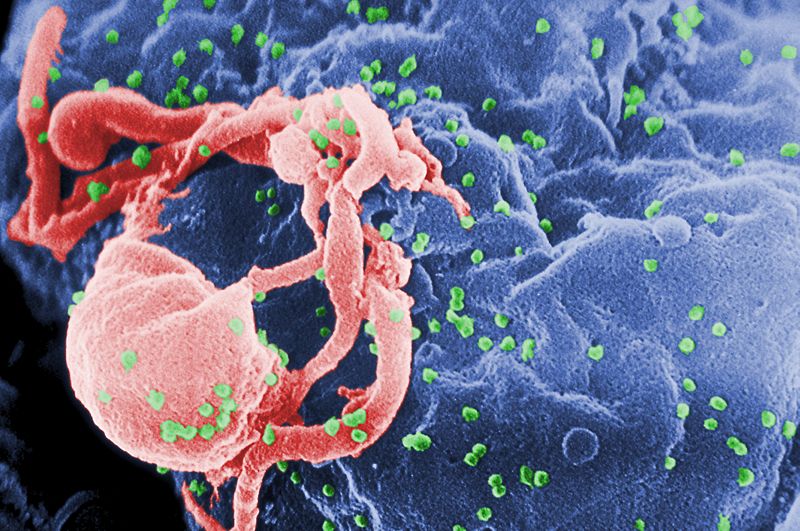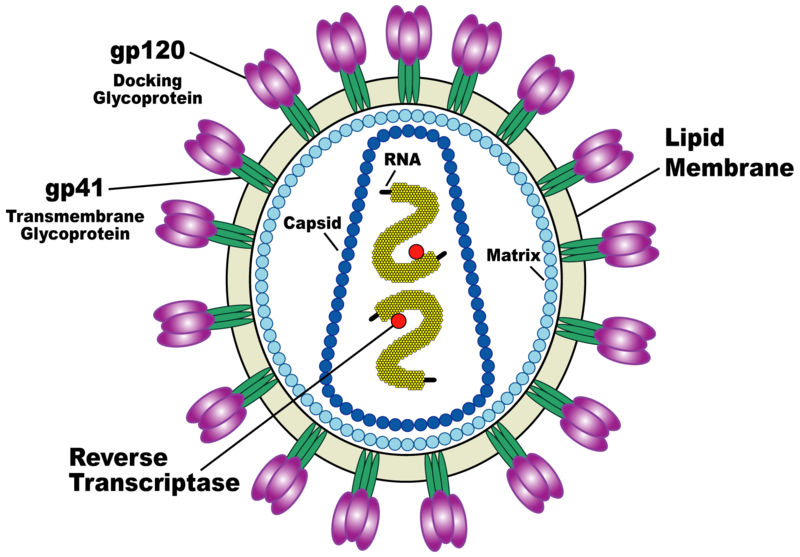The Origins of HIV
Interview with
Chris - When did HIV first pop up in humans?
Mike - Well this study that we recently published we used some archival samples. We went into a time machine back to 1960 and sequenced a variant of HIV from that time period. From that vantage point it became possible to home in on when we think the pandemic strain first started circulating in humans. It's pretty early. The virus may be celebrating its hundredth anniversary in humans. Our best guess is about 1908 + or - 20 years.
 Chris - First of all, let's take a look at how you came by these samples. What was the work that led up to being able to say I've got samples from 1960?
Chris - First of all, let's take a look at how you came by these samples. What was the work that led up to being able to say I've got samples from 1960?
Mike - Actually it kind of traces back to last time we talked four years ago. It was regarding some work I'd done collecting virus samples from chimpanzees in the Congo so that's one way you can go about investigating the origins of the virus. You can look at the modern counterparts in the reservoir species. At that time, actually even before that, I started thinking about ways that you could get at it. The obvious thing was to try to get human samples that go really far back in time and the state of the situation at that time was we had one little glimpse. A fragmentary sequence from one HIV patient from 1959 and then there was no sequence at all until the late 1970s, early 80s.
Chris - That 1959 sample was a blood sample that someone had luckily stored in a freezer for years, wasn't it?
Mike - Exactly, it was something that was collected for other reasons. It was genetic research to do with malaria but someone had the foresight to save those samples. Central African blood samples that go back that far in time are hard to find. I think most people just kind of gave up. They thought when we got the 1959 one we're not going to find any more, that this is all we have. What I thought about was are there other kinds of samples that aren't in freezers and aren't so delicate? I turned to paraffin embedded, wax tissue specimens, biopsies and autopsy specimens. They're routinely taken in hospitals and clinics around the world and put in a cellar and archived. It turns out it's kind of painstaking but you can get gene sequences out of these things.
Chris - Who happened to have some of the right sorts of paraffin-embedded tissue you could study?
 Mike - The one that yielded this sample from 1960 was actually stored in Kinshasa, the capital of the Congo at the University of Kinshasa. What i did for quite a few years actually was just put out feelers and do some work and talk to a lot of old Belgian scientists and physicians who had connections who had either done work in the Congo back in the day or knew people who did. Eventually turned up many old samples like this and, like I said, they were samples that had sat in Kinshasa all this time that yielded this sequence.
Mike - The one that yielded this sample from 1960 was actually stored in Kinshasa, the capital of the Congo at the University of Kinshasa. What i did for quite a few years actually was just put out feelers and do some work and talk to a lot of old Belgian scientists and physicians who had connections who had either done work in the Congo back in the day or knew people who did. Eventually turned up many old samples like this and, like I said, they were samples that had sat in Kinshasa all this time that yielded this sequence.
Chris - So you go to old human tissue, you go to 40+ years ago and you can find HIV in that. What does that tell you about where HIV came from and how do you wind back the genetic clock to find out when it first popped up in humans?
Mike - The first thing that tells us is you can compare the 1960 Kinshasa sequence to the 1959 Kinshasa sequence. It's like having a human genome, it's great and tells you lots of things. As soon as you have a chimp genome to compare against it there's a whole lot of other things you can tell by comparing. Once we have these two viruses side by side we could see that they were pretty surprisingly divergent. Even at that early date in 1960 a direct comparison of that early sequence indicated these things had spent a long time evolving away from their common ancestor: decades and decades. The other thing that we could do now is plug those early sequences into a more sophisticated analysis using more that 100 sequences worldwide. They really helped calibrate the molecular clock of these viruses and allowed us to estimate with a lot of precision when the virus started spreading in humans. Like I said, it's many decades before 1960.
Chris - but something must have happened 100 years ago in that part of Africa to make that HIV appear. The closest relative of HIV is SIV: the virus which you find in chimpanzees. What was going on in that part of Africa that meant this chimpanzee virus got into people?
 Mike - This is one of the coolest things about the finding. There are all sorts of SIVs from different primates that are circulating out there. The big question is if these things have been around why didn't they cross in earlier or later? Why now, at this point? When we matched up the timing of these genetic analyses of the viruses against what was happening in that epicentral region of Africa for me it was a surprise. I didn't realise how little urbanisation there was in the region until that time. Basically, in the whole area around southeast Cameroon where we think the chimp virus produced the pandemic strain of AIDS entered humans there were basically no cities at the turn of the 19th century. It wasn't until that time that places like Kinshasa were established as colonial administrative trading centres.
Mike - This is one of the coolest things about the finding. There are all sorts of SIVs from different primates that are circulating out there. The big question is if these things have been around why didn't they cross in earlier or later? Why now, at this point? When we matched up the timing of these genetic analyses of the viruses against what was happening in that epicentral region of Africa for me it was a surprise. I didn't realise how little urbanisation there was in the region until that time. Basically, in the whole area around southeast Cameroon where we think the chimp virus produced the pandemic strain of AIDS entered humans there were basically no cities at the turn of the 19th century. It wasn't until that time that places like Kinshasa were established as colonial administrative trading centres.
Chris - So you think it was people moving in and establishing cities that got the thing going?
Mike - I think it's almost too much of a coincidence to dismiss that what I think happened was, HIV is a fairly poorly transmitted virus human-to-humans. You have to set the stage for it to survive and create a chain of transmission otherwise viruses entering from chimps might get into one or two people but then die out.
Chris - So what do you think happened?
Mike - Well, with the advent of cities in the region cities make life a lot easier for HIV. They bring people into high densities. You often have high-risk behaviours like prostitution that facilitate the movement of the virus from person to person. We talk about this magic number of viruses: a basic reproductive number of one. This means a virus which your average infected person infects one other person will persist in the population. If it's below that number it will become extinct. The advent of urbanisation may have pushed that magic number above one for HIV.
Chris - Briefly, I think one of the other things to mention might be people immunising people. When they set up cities weren't they exploring vaccines in those early days? Could that also have been how it happened because people weren't so rigorous with sterilising needles as we are now?
Mike - It's definitely one of the things that have been discussed as a possible player in the establishment of the virus. My thinking is if you actually look at the timing of those events people like Preston Marx have talked about the spread of disposable needles. That's actually in a large part after the timing that we're pointing to. The bulk of the transmission of the virus in sub-Saharan Africa today is through sexual transmission. I don't see any reason to think that the establishment of the virus had things to do with things like dirty needles. They probably play a minor role in transmission but I don't think they're the key.
- Previous Catching New Viruses
- Next Hotspots for Emerging Disease










Comments
Add a comment